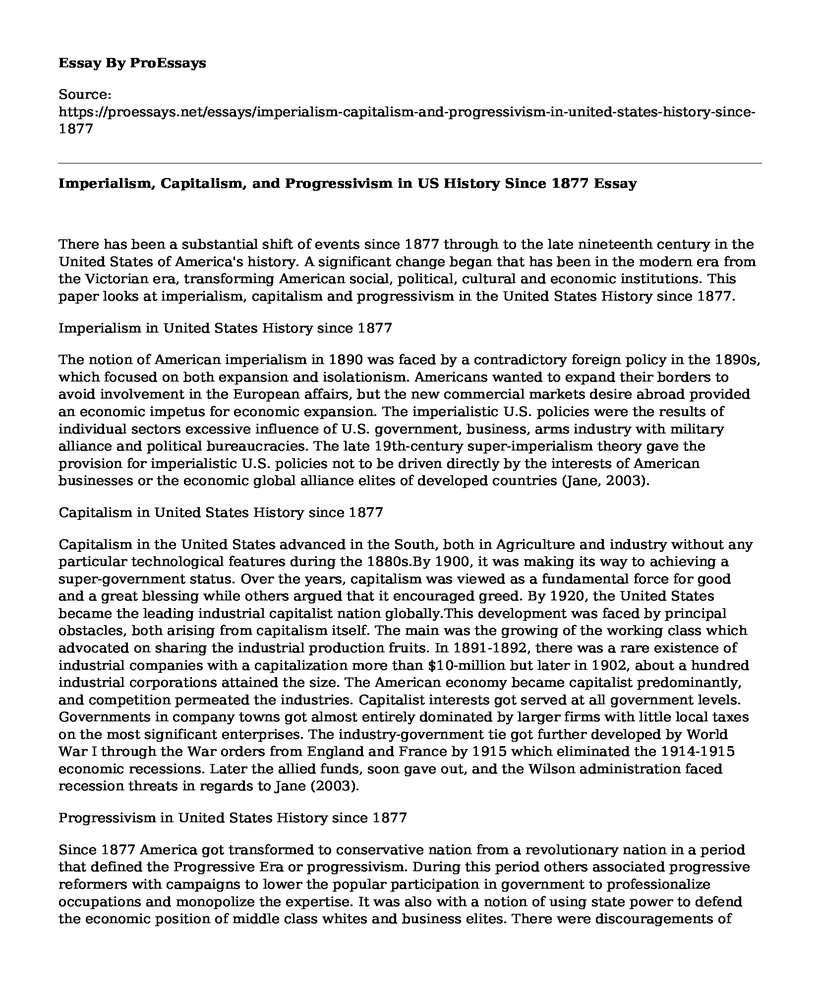There has been a substantial shift of events since 1877 through to the late nineteenth century in the United States of America's history. A significant change began that has been in the modern era from the Victorian era, transforming American social, political, cultural and economic institutions. This paper looks at imperialism, capitalism and progressivism in the United States History since 1877.
Imperialism in United States History since 1877
The notion of American imperialism in 1890 was faced by a contradictory foreign policy in the 1890s, which focused on both expansion and isolationism. Americans wanted to expand their borders to avoid involvement in the European affairs, but the new commercial markets desire abroad provided an economic impetus for economic expansion. The imperialistic U.S. policies were the results of individual sectors excessive influence of U.S. government, business, arms industry with military alliance and political bureaucracies. The late 19th-century super-imperialism theory gave the provision for imperialistic U.S. policies not to be driven directly by the interests of American businesses or the economic global alliance elites of developed countries (Jane, 2003).
Capitalism in United States History since 1877
Capitalism in the United States advanced in the South, both in Agriculture and industry without any particular technological features during the 1880s.By 1900, it was making its way to achieving a super-government status. Over the years, capitalism was viewed as a fundamental force for good and a great blessing while others argued that it encouraged greed. By 1920, the United States became the leading industrial capitalist nation globally.This development was faced by principal obstacles, both arising from capitalism itself. The main was the growing of the working class which advocated on sharing the industrial production fruits. In 1891-1892, there was a rare existence of industrial companies with a capitalization more than $10-million but later in 1902, about a hundred industrial corporations attained the size. The American economy became capitalist predominantly, and competition permeated the industries. Capitalist interests got served at all government levels. Governments in company towns got almost entirely dominated by larger firms with little local taxes on the most significant enterprises. The industry-government tie got further developed by World War I through the War orders from England and France by 1915 which eliminated the 1914-1915 economic recessions. Later the allied funds, soon gave out, and the Wilson administration faced recession threats in regards to Jane (2003).
Progressivism in United States History since 1877
Since 1877 America got transformed to conservative nation from a revolutionary nation in a period that defined the Progressive Era or progressivism. During this period others associated progressive reformers with campaigns to lower the popular participation in government to professionalize occupations and monopolize the expertise. It was also with a notion of using state power to defend the economic position of middle class whites and business elites. There were discouragements of radical politics and discrediting of democratic values, the reforms, and the progressive eras political changes. More recent historians in the field have, in many ways, argued on more pluralistic views of the period, giving views that low and middle-income New Yorkers directly influenced the political decisions through special interest groups, and indirectly through their demonstrations, votes, and strikes. However, over the years, popular feelings became strong enough to put in place the new economic policies adoption despite the policies not being strong enough to prevent the nature of the reforms shaped by the more organized and powerful interests. This was not believed as a channel of creating new synthesis for Progressivism. There was a feeling that for other comparable views needed to be undertaken before the creation of such a synthesis. This had been the state of Progressive historiography until the recent absence of a synthesis and a plethora of interpretations according to Jane2003).
Reference
Jane, C. I. (2003). American history, 1877 to the present. Hauppauge, NY: Barron's
Cite this page
Imperialism, Capitalism, and Progressivism in US History Since 1877. (2021, Mar 11). Retrieved from https://proessays.net/essays/imperialism-capitalism-and-progressivism-in-united-states-history-since-1877
If you are the original author of this essay and no longer wish to have it published on the ProEssays website, please click below to request its removal:
- Should The Government Surveil The Citizens Electronically? - Essay Sample
- Huawei Enters the United States Essay Example
- Unemployment and Inflation Rate in the UK Essay
- Essay Example on Soldiers' Sacrifices for Patriotism: Exploring War and Violence in Iraq
- Ancient Greek Homosexuality: The Pederastic Relationship - Essay Sample
- Workers' Comp: Get Compensated for Job-Related Illnesses & Accidents - Essay Sample
- U.S. Gov't Forced Native Americans to Settle in Unfavorable Lands - Essay Sample







